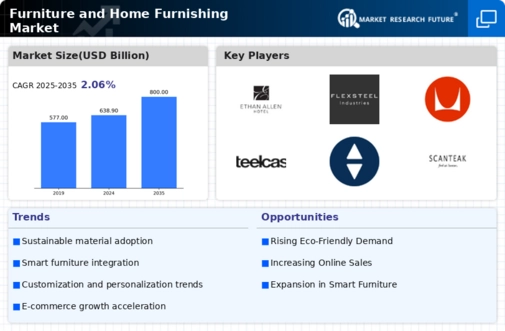E-commerce Growth
The rapid growth of e-commerce is a significant driver for the Global Furniture and Home Furnishing Market Industry. Online shopping platforms provide consumers with a vast array of choices and convenience, allowing them to browse and purchase furniture from the comfort of their homes. This trend has been accelerated by advancements in logistics and delivery services, making it easier for consumers to receive large items. As e-commerce continues to expand, it is expected to capture a larger share of the market, contributing to the overall valuation of 800 USD Billion by 2035.
Rising Urbanization
Urbanization is a prominent driver of the Global Furniture and Home Furnishing Market Industry. As more individuals migrate to urban areas, the demand for residential and commercial furniture increases. In 2024, the market is valued at approximately 638.9 USD Billion, reflecting the growing need for space-efficient and multifunctional furniture. Urban dwellers often seek stylish yet practical solutions to optimize their living spaces, which propels innovation in design and functionality. This trend is expected to continue, as urban populations are projected to rise, further stimulating market growth.
Sustainability Trends
The increasing emphasis on sustainability significantly influences the Global Furniture and Home Furnishing Market Industry. Consumers are increasingly favoring eco-friendly materials and sustainable production practices. This shift is evident in the growing popularity of furniture made from reclaimed wood and recycled materials. Companies that adopt sustainable practices not only enhance their brand image but also attract environmentally conscious consumers. As the market evolves, it is anticipated that sustainable furniture will constitute a larger share of the overall market, contributing to the projected growth to 800 USD Billion by 2035.
Market Growth Projections
The Global Furniture and Home Furnishing Market Industry is projected to experience substantial growth over the coming years. With a market valuation of 638.9 USD Billion in 2024, it is anticipated to reach 800 USD Billion by 2035. This growth trajectory suggests a steady increase in demand across various segments, driven by factors such as urbanization, sustainability, and technological advancements. The expected CAGR of 2.06% from 2025 to 2035 indicates a stable market environment, providing opportunities for businesses to innovate and expand their offerings.
Technological Advancements
Technological advancements are reshaping the Global Furniture and Home Furnishing Market Industry. Innovations such as 3D printing and smart furniture are gaining traction, allowing for customization and enhanced functionality. For instance, smart furniture equipped with charging ports and integrated technology is becoming increasingly popular among tech-savvy consumers. These advancements not only improve the user experience but also streamline production processes, potentially reducing costs. As the market adapts to these technological changes, it is likely to see a steady growth rate, with a projected CAGR of 2.06% from 2025 to 2035.
Changing Consumer Preferences
Changing consumer preferences play a crucial role in shaping the Global Furniture and Home Furnishing Market Industry. Modern consumers are increasingly seeking personalized and unique furniture pieces that reflect their individual styles. This shift has led to a rise in demand for bespoke furniture and artisanal designs. Additionally, the influence of social media and interior design trends has heightened consumer awareness and desire for aesthetically pleasing home environments. As these preferences evolve, they are likely to drive innovation and diversification within the market, supporting its growth trajectory.






















